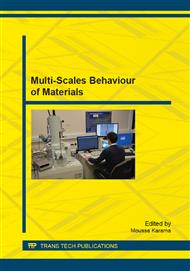p.12
p.27
p.39
p.51
p.64
p.74
p.83
p.96
p.112
Study of Mechanical Behavior of Concrete in Direct Tensile Fiber Chips
Abstract:
In this experimental study, we are interested in local fiber wavy chips derived from waste machining steel parts. This work has focused on studying the mechanical behavior of reinforced concrete, with this type of fiber, in direct tensile. Direct tensile tests were carried out on samples in free weights section and square (100x100) mm2. This test involves the design and the implementation of special mounting specimens on the tensile machine type Ibertest. Five (05) fibers percentages were retained in (W = 0.5%. W = 0.8%, W = 1%, W = 1.2%, W = 1.5% with W: volume fraction of added fiber) and two (02) concrete witness whose report on gravel sand is equal to: S / G = 0.8 and S / G = 1. The fibers have been characterized to the strength and tear by the tensile test. The interest lies in optimizing the fiber length and the number of undulations to use in a cement matrix, which will improve the mechanical properties especially tensile strength and post-cracking behavior. The comparison of different results obtained in direct tension on different percentages of fiber, as well as two reports showed that the fibers have conferred a significant ductility to the material after cracking of concrete for different percentages of fiber and a strength for improving the S / G = 0.8.
Info:
Periodical:
Pages:
64-73
Citation:
Online since:
December 2011
Authors:
Keywords:
Price:
Сopyright:
© 2012 Trans Tech Publications Ltd. All Rights Reserved
Share:
Citation:


